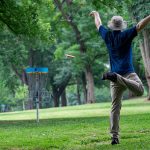In disc golf, accidents can happen quickly, often without warning. A bad throw, a misjudged jump, or an awkward landing can result in a serious injury. Despite the relatively low risk of injury compared to other contact sports, disc golf injuries can be severe and may even keep you sidelined for an extended period. By understanding the common injuries and taking preventive measures, you can reduce your risk of getting hurt and stay healthy to enjoy the game to its fullest.
Common Disc Golf Injuries
Several types of injuries are more common in disc golf players, including:
- Back and shoulder strain
- Knee and ankle sprains
- Shin splints
- Acl/Mcl tears
- Elbow and wrist strain
Many of these injuries are the result of overuse or improper technique, while others are caused by falls, awkward landings, or other external factors. Proper preparation, warm-up exercises, and injury prevention techniques can help minimize the risk of getting hurt.
Stretching and Warm-Up Exercises
A well-designed stretching routine can help prevent injuries and improve flexibility. Make sure to stretch your major muscle groups, including your legs, back, shoulders, and hips. Some important stretches for disc golf include:
- Quadriceps stretch: Stand with one hand against a wall and lift one leg behind you, keeping your knee straight. Hold for 15-30 seconds and repeat on the other side.
- Hamstring stretch: Sit on the floor with your legs straight out in front of you. Lean forward, reaching for your toes, and hold for 15-30 seconds.
- Calves stretch: Stand with your feet shoulder-width apart and lean forward, keeping your heels on the ground. Hold for 15-30 seconds.
- Chest stretch: Stand with your feet shoulder-width apart and place your hands on a wall or doorframe at shoulder height. Lean forward, stretching your chest and shoulders, and hold for 15-30 seconds.
- Neck stretch: Slowly tilt your head to the side, bringing your ear towards your shoulder. Hold for 15-30 seconds and repeat on the other side.
In addition to stretching, a proper warm-up exercise routine can also help prevent injuries. Examples of warm-up exercises include jogging, jumping jacks, or light cardio, followed by dynamic stretches, such as leg swings, hip circles, and arm movements.
Injury Prevention Techniques
Besides stretching and warm-up exercises, there are several injury prevention techniques that disc golfers can use to stay healthy and avoid common injuries. Some of these include:
- Using proper technique: Focus on proper throwing and catching technique to avoid putting unnecessary strain on your body.
- Wearing protective gear: Wearing knee and elbow pads can help protect against minor cuts and bruises, while more severe injuries may require wrist, shoulder, or spine guards.
- Building endurance: Improving your endurance can help you maintain energy levels and avoid fatigue during longer games or rounds.
- Listening to your body: Pay attention to your body’s warning signs and take regular breaks to rest and recover.
- Staying hydrated: Proper hydration can help reduce muscle soreness and improve overall performance.
Preventive Measures for Specific Injuries
In addition to the general injury prevention techniques and stretching routine, there are some specific measures that disc golfers can take to prevent certain injuries:
Preventing Back and Shoulder Strains
- Avoid bending or twisting motions during play.
- Strengthen your core muscles through exercises like planks and sit-ups.
- Wear a supportive brace or back belt during play.
Preventing Knee and Ankle Sprains
- Avoid twisting or bending movements during play.
- Strengthen your ankles through exercises like single-leg squats and balance boards.
- Wear knee and ankle pads or sleeves for added support and protection.
Preventing Shin Splints
- Gradually increase your throwing distance and intensity to avoid putting excessive stress on your shins.
- Stretch and strengthen your calf and ankle muscles through exercises like calf raises and single-leg squats.
- Use orthotics or shoe inserts to redistribute pressure and reduce stress on your shins.
Preventing Acl/Mcl Tears
- Avoid quick stops and sudden changes in direction during play.
- Strengthen your knees through exercises like squats, lunges, and leg press.
- Use knee sleeves or supports for added stability and protection.
Preventing Elbow and Wrist Strains
- Avoid using your arms to compensate for a bad throw.
- Strengthen your forearm muscles through exercises like wrist curls and extensions.
- Wear elbow and wrist guards for added protection and support.
Conclusion
In conclusion, disc golf injuries can be serious and debilitating, but they can be prevented through proper stretching, warm-up exercises, and injury prevention techniques. By understanding common injuries, taking preventive measures, and staying healthy, disc golfers can continue to enjoy the game for years to come. Remember to listen to your body, take regular breaks, and prioritize your safety to minimize the risk of getting hurt.
FAQs
Q: What are some common injuries in disc golf?
A: Some common injuries in disc golf include back and shoulder strains, knee and ankle sprains, shin splints, Acl/Mcl tears, and elbow and wrist strains.
Q: How can I prevent common injuries in disc golf?
A: To prevent common injuries, focus on proper stretching and warm-up exercises, use proper throwing and catching technique, and take regular breaks to rest and recover. Additionally, consider wearing protective gear such as knee and elbow pads.
Q: What are some effective stretches for disc golf?
A: Some effective stretches for disc golf include quadriceps, hamstring, calf, chest, and neck stretches. It’s also important to include dynamic stretches such as leg swings, hip circles, and arm movements as part of your warm-up routine.
Q: What are some ways to improve my endurance in disc golf?
A: To improve your endurance, focus on cardio exercises such as jogging or cycling, and incorporate strength training exercises that target your legs, core, and upper body. Additionally, make sure to stay hydrated and take regular breaks to rest and recover.








